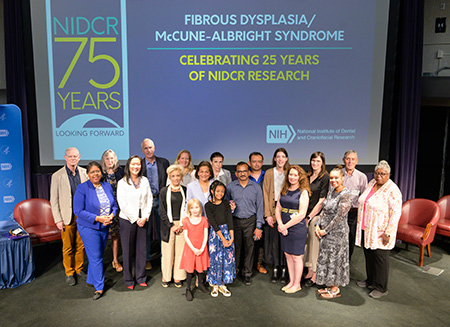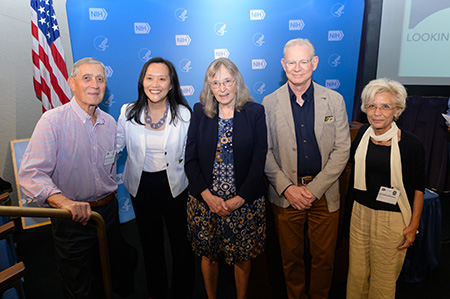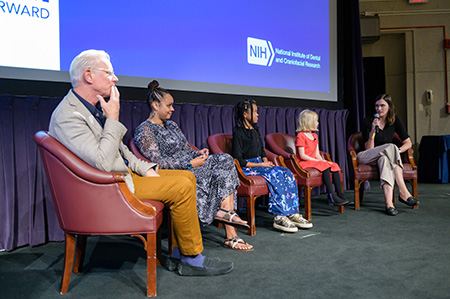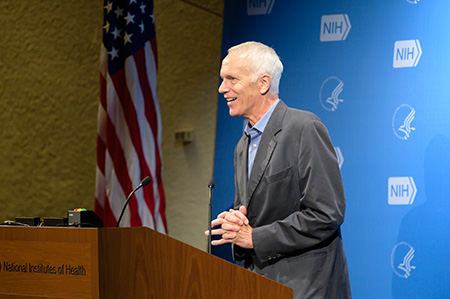A 25-Year Scientific Quest Offers Hope for Patients With Rare Disorder
Symposium celebrates legacy of NIDCR research on fibrous dysplasia/McCune-Albright syndrome
Seven-year-old Jianna Monchais was an enigma to doctors as an infant. Physicians struggled to explain the large birthmarks across her body and puzzled over why she started menstruating as a baby. Some years earlier, and hundreds of miles away, Kelly Cohen had noticed similar birthmarks on her son, Liam, who, by his fifth birthday, had broken his femur — the strongest bone in the body — multiple times. Both families have received answers and expert care over the years from clinician-scientists at the National Institutes of Health. Some of them also traveled to the NIH campus in Bethesda to participate in the symposium Fibrous Dysplasia/McCune-Albright Syndrome: Celebrating 25 Years of NIDCR Research on September 11, 2023.
Jianna and Liam have fibrous dysplasia/McCune Albright Syndrome (FD/MAS), a rare disease of the skeleton, skin, and endocrine system. Possible signs of the disease include weak, malformed bones that break easily, puberty that starts as early as infancy, and birthmarks. The disease can be extremely painful, disabling, and diminish quality of life.
The impact of the diagnosis was softened by their experience at NIH, including with NIDCR pediatric endocrinologist Alison Boyce, M.D.
“I’ve never felt so cared for,” said Jianna’s mother Voncia Monchais about their first consultation with Dr. Boyce, who answered every question regarding Jianna’s condition. “Dr. Boyce said, ‘We have this team for her, and she’s going to have this team for her life,’ and that has brought all the comfort.”
Dr. Boyce and her colleagues at NIDCR are more than long-term allies to individuals with FD/MAS and their families. They are world-renowned leaders in the search for a better standard of care for people with the disease. They are also key members of the NIDCR scientific program that has focused on FD/MAS for 25 years.
As part of NIDCR’s 75th anniversary, the institute held the symposium to celebrate the quarter-century legacy of this program and to highlight its future directions. The event featured talks from Nobel Laureate Brian Kobilka, M.D., from Stanford University; former Director of the National Institute of Diabetes and Digestive and Kidney Diseases (NIDDK), Allen Spiegel, M.D.; FD/MAS scientific leaders, including NIDCR researchers; patients; and patient advocates.
Tracing the Root of the Rare Disease
First described in medical journals in 1937, FD/MAS is a nonhereditary genetic disorder that first appears in early childhood. Scientists didn’t know the cause of it until more than 50 years later when an NIDDK team led by Dr. Spiegel, who kicked off the symposium, solved the mystery.
During his talk, Dr. Spiegel recounted his group’s work in the 1980s and 1990s studying diseases that arise from mutations in a family of proteins called G proteins, and their corresponding receptors, called G-protein-coupled receptors. Collectively, these molecules are vital for the proper functioning of a wide range of biological processes, including those of the immune, nervous, and endocrine systems.
In 1991, Dr. Speigel’s group found that a mutation in one member of the G protein family — Gαs — causes the skin and hormonal effects of the disease. But, he wondered, does it also cause skeletal abnormalities, and if so, how? To find out, Dr. Spiegel visited NIDCR bone stem cell biologist Pamela Robey, Ph.D., with a box full of bone samples collected from patients with FD/MAS.
“My first impression when I was looking down the microscope was ‘This is a disease of bone [stem] cells that have gone wild,’” Dr. Robey recalled during her symposium presentation. Unlike healthy bone, the diseased bone was disorganized, poorly mineralized, and riddled with scar-like fibrous tissue.
Soon after Dr. Speigel’s visit, Dr. Robey and her colleagues discovered that the Gαs mutation impairs skeletal stem cells’ ability to develop into mature bone cells. The mutation-carrying cells multiply rapidly and form immature bone that doesn’t quite harden, resulting in weak regions throughout. These faulty patches, or lesions, cause bones to bow and break easily. They can also expand and press against organs and nerves, impairing vision, hearing, and breathing. While there are approved drugs for hormonal symptoms of the disease, none exist to slow or curb the growth of bone lesions.
Patients at the Center of Research
Given NIDCR’s expertise in bone biology, Dr. Robey saw an opportunity to learn more about the skeletal aspects of FD/MAS, and maybe even develop treatments. Along with NIDCR endocrinologist Michael Collins, M.D., who was then a clinical fellow, she launched a research project, called a natural history study, to document the nature and progression of the disease. In his symposium talk, Dr. Collins recalled the study’s launch in 1998. Since then, he said, the study has enrolled more than 300 patients ages 1 to 102.
In the natural history study, which Dr. Boyce has led since 2016, clinicians study patients from head to toe. They record symptoms, take bone scans, collect tissue samples, document every characteristic of the disease, and detail patients’ responses to treatments.
Dr. Collins explained how the study has revealed that bone lesions tend to develop before age 15. This led to the hypothesis that an effective treatment, if administered early, might be able to prevent the most serious impacts of FD/MAS. Results from the study have also informed better standards of care, including showing that certain surgical procedures might be unnecessary and even harmful.
Dr. Collins noted that the severity and extent of disease is unique to each patient, which poses a challenge for treatment. He described how he worked with Dr. Boyce to address this issue by creating a clinical decision-making algorithm. The algorithm allows clinicians to input a patient’s symptoms and receive a treatment plan tailored to that patient’s unique situation.
The Search for a Bone Treatment
The natural history study has also spurred the development of animal and cell models with FD/MAS-like characteristics to aid research and test new therapies.
Patients with FD/MAS have excessive bone turnover, the process by which old bone is continually replaced with new bone. In her presentation, Mara Riminucci, M.D., from Sapienza University, Italy, showed that blocking RANKL, a protein responsible for excessive bone turnover, can prevent the formation of new bone lesions in mice. The study added to evidence that an FDA-approved RANKL-blocking osteoporosis drug called denosumab might hold promise for patients.
Dr. Boyce spoke about how that hypothesis was put to the test in a recent NIDCR clinical trial she led. Eight adults with FD/MAS were given denosumab, which markedly reduced abnormal bone turnover — an indication of improved bone quality and strength. While denosumab showed promise, bone turnover returned for all but one participant after the medication was stopped. Dr. Boyce noted that clinicians should factor in this risk when treating patients.
“What was particularly encouraging is [the results were] accompanied by really profound improvements in clinical outcomes,” said Dr. Boyce. Participants reported reduced complications while taking denosumab. One with lesions in the ribs noted increased lung function within a month of treatment. Dr. Boyce’s team is now testing whether early intervention with denosumab in children can prevent FD/MAS lesions from forming in the first place.
Beyond FD/MAS Research
The final speaker, Dr. Kobilka, described his Nobel-winning research on the receptor family at the heart of FD/MAS – G-protein-coupled receptors. Close to half of all approved drugs act on this group of proteins, including antihistamines, antidepressants, and opioids. Citing his research to develop nonaddictive opioids as an example, Dr. Kobilka highlighted the progress, challenges, and opportunities in G-protein-coupled receptor drug discovery. These principles may help guide the discovery of therapeutic molecules that act on the faulty Gαs protein underlying FD/MAS.
The researchers credited the patient community, including the U.S.-based FD/MAS Alliance and the International Consortium for FD/MAS, whose members participated in the symposium, for driving research, advocating for patients’ needs, and supporting patients and families to navigate the rare disorder.
NIDCR Director Rena D’Souza, D.D.S., Ph.D., closed out the event with a message of optimism: “We move from a place of uncertainty to one of hope, from limited treatment options to a future where personalized therapies are within reach. Fibrous dysplasia/McCune-Albright is no longer an insurmountable challenge but a field ripe with possibilities.”
Related Links
- A Quarter-Century Quest to Treat a Rare Disease
- Therapy for Rare Bone Disorder Shows Promise in NIH Clinical Trial
- Cracking Down on a Rare Bone Disorder
References
Bianco P, Kuznetsov SA, Riminucci M, Fisher LW, Spiegel AM, Robey PG. Reproduction of human fibrous dysplasia of bone in immunocompromised mice by transplanted mosaics of normal and Gsalpha-mutated skeletal progenitor cells. J Clin Invest. 1998 Apr 15;101(8):1737-44. doi: 10.1172/JCI2361.
Boyce AM, Florenzano P, de Castro LF, Collins MT. Fibrous Dysplasia / McCune-Albright Syndrome. 2015 Feb 26 [Updated 2019 Jun 27]. In: Adam MP, Mirzaa GM, Pagon RA, et al., editors. GeneReviews® [Internet]. Seattle (WA): University of Washington, Seattle; 1993-2023.
de Castro LF, Michel Z, Pan K, Taylor J, Szymczuk V, Paravastu S, et al. Safety and Efficacy of Denosumab for Fibrous Dysplasia of Bone. N Engl J Med. 2023 Feb 23;388(8):766-768. doi 10.1056/NEJMc2214862.
Lee JS, FitzGibbon E, Butman JA, Dufresne CR, Kushner H, Wientroub S, et al. Normal vision despite narrowing of the optic canal in fibrous dysplasia. N Engl J Med. 2002 Nov 21;347(21):1670-6. doi: 10.1056/NEJMoa020742.
Palmisano B, Spica E, Remoli C, Labella R, Di Filippo A, Donsante S, et al. RANKL Inhibition in Fibrous Dysplasia of Bone: A Preclinical Study in a Mouse Model of the Human Disease. J Bone Miner Res. 2019 Dec;34(12):2171-2182. doi: 10.1002/jbmr.3828. Epub 2019 Aug 21.
Shenker A, Weinstein LS, Sweet DE, Spiegel AM. An activating Gs alpha mutation is present in fibrous dysplasia of bone in the McCune-Albright syndrome. J Clin Endocrinol Metab. 1994 Sep;79(3):750-5. doi: 10.1210/jcem.79.3.8077356.
Attention Editors
Reprint this article in your own publication or post to your website. NIDCR News articles are not copyrighted. Please acknowledge NIH's National Institute of Dental and Craniofacial Research as the source.
Subscribe for NIDCR Updates
Receive email updates about the latest advances in dental, oral, and craniofacial research.
November 2023




